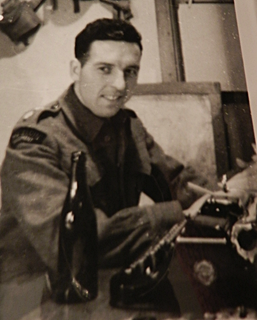Intro to Recollections With the presence of mind of an officer who was awarded the VD and was later the Commanding Officer of the Elgin Regiment, Lt. Col. Warren Andrews recorded his encounter with General Sir Arthur Currie, Commander of Canadian Troops and Kenneth Lawrence the last Canadian casualty of the Great War. The occasion was a celebratory dinner for thousands in St. Thomas, Ontario in 1921. The encounter did not begin well. |
|
1 Comment
About the Author
H-Hour When daylight came, we saw the magnitude of the operation. There were ships as far as one could see. At H-Hour, massive attacks on the beach defences were begun by naval units while bombers attacked from air. The biggest naval guns were directed at targets inland and they were still firing inland more than six weeks after D-Day. The shells coming through the sky sounded like trains as they passed over overhead.
The rocket ships provided the most spectacular sights. The rockets went off in groups of ten or so, with only seconds between groups. It was a fiery show as hundreds of rockets were shot from the banks of pipes on the decks of the rocket ships. Lt. Colonel Robert S. Chamberlain, MC, C St. J, CD - A lifetime of service with the Perth Regiment with whom he served during WW II winning the Military Cross in Italy; the Elgin Regiment as Honorary Commanding Officer for 15 years, and with the Elgin Military Museum (seen above with Lt. Col. Ed King (centre) and Lord Elgin (right) in the Museum in the early 1980s).
Boys in “C” Squadron Hit |
| Just prior to the invasion, “C” Squadron of the Elgins was stationed at Gosport on the southern coast of England. The men had been warned of air raids and told to dig slit trenches, as learned in previous training. But they had not done so. The second night the squadron was there, the German Air Force carried out a heavy raid on Portsmouth and Gosport and several bombs were dropped nearby. Don McLachlin, Charlie Raven and I went to get into our slit trench but found it was already occupied. The next morning there was dirt flying in all directions as the men dug deep into old Mother Earth. |
Elgins Left Old Syracuse
In Big Hurry on the Night
of Their Sicilian Landing
Commanding “A” Squadron, Elgin Regiment
The Elgins – or some of the Elgins – first got into action in Sicily. There are incidents – highlights and lowlights – connected with that campaign that I am sure few of the boys will ever forget. Time has a tendency to make them amusing but there weren’t so funny when they occurred. We left the British Isles on June 25, 1943 and finally reached Algiers – and still we didn’t know where we were going. Then the invasion was on and we were taken down near the island of Pantellaria. Every morning, for three mornings, we’d wake up and see some island out in front of us.
We seemed to be going around in circles. The next thing we knew we were in Malta, and sat there for a day. Then on the night of July 15 we started for Syracuse and were going to land. We knew where we were going then.
Author
The Elgin Military Museum has a vast collection of letters, articles, poems and pictures of veterans and others who served their community over a period of two hundred years.. This blog is our way of sharing them with you.
Archives
April 2020
February 2020
January 2020
June 2019
March 2019
February 2019
January 2019
December 2018
November 2018
February 2018
December 2017
November 2017
June 2017
May 2017
December 2016
November 2016
September 2016
Categories
All
Air Force
Army
Bridge Too Far
Caterpillar Club
Ceremonies
Christmas
Churchill
Citations
Confidential Book Box
D Day
Devil's Brigade
Dieppe
Elgin Military Museum
Elgin Regiment
Goldfish Club
Italian Campaign
Late Arrivals Club
Letters
Merchant Marine
Military Camps
Military Cross
Military Medical Care
Momentous Events
Nursing
Obituaries
PPCLI
Radar
Red Cross
Roosevelt
Royal Canadian Navy
Royal Navy
Tanks
Trench Warfare
U Boats
WW I
WW II




 RSS Feed
RSS Feed